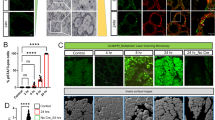Abstract
Objective
The immediate effects of oxytocin on myometrial signal transduction have been described. However, the longer term effects (up to an hour) on the myometrial proteome have not. We combined in vitro contractility with proteomic analysis to determine the protein changes associated with oxytocin-induced myometrial activity.
Study Design
Human myometrial biopsies were taken at elective caesarean section prior to administration of oxytocics. Strips were mounted in an organ bath and exposed to oxytocin (10−8 mol/L), the oxytocin antagonist L372,662 (10−7 mol/L), or vehicle (n = 5 for each) for 60 minutes. Contractility was determined and expressed as a percentage of pretreatment for each strip. At the end of the contractility experiment, proteins were extracted and separated by two-dimensional (2D) gel electrophoresis. Two-dimensional gels were analyzed by PDQuest and proteins of interest identified by mass spectrometry.
Results
Identified proteins that demonstrated differences as a result of treatment with oxytocin or the oxytocin receptor antagonist L372,662 were Annexin-A3, Osteoglycin, HSP70-protein 2, 2 isoforms of Cytokeratin 19, Desmin, EHD2, Protein disulfide isomeraseA3, BIGH3, transgelin, thioredoxin reductase, triose phosphate isomerase, pyruvate kinase, elongation factor 1γ, and α-Actin-3. These proteins can be grouped into 5 classes of protein, those associated with cytoskeletal function, contractile/oxidative stress, protein synthesis, extracellular matrix proteins, and energy metabolism.
Conclusion
This study demonstrates that oxytocin has longer term (1 hour) effects on the myometrial proteome.
Similar content being viewed by others
References
Chibbar R, Miller FD, Mitchell BF. Synthesis of oxytocin in amnion, chorion, and decidua may influence the timing of human parturition. J Clin Invest. 1993;91(1):185–192.
Blanks AM, Vatish M, Allen MJ, et al. Paracrine oxytocin and estradiol demonstrate a spatial increase in human intrauterine tissues with labor. J Clin Endocrinol Metab. 2003;88(7): 3392–3400.
Reinheimer TM, Bee WH, Resendez JC, Meyer JK, Haluska GJ, Chellman GJ. Barusiban, a new highly potent and long-acting oxytocin antagonist: pharmacokinetic and pharmacodynamic comparison with atosiban in a cynomolgus monkey model of preterm labor. J Clin Endocrinol Metab. 2005;90(4):2275–2281.
Reinheimer TM, Chellman GJ, Resendez JC, Meyer JK, Bee WH. Barusiban, an effective long-term treatment of oxytocin-induced preterm labor in nonhuman primates. Biol Reprod. 2006;75(5):809–814.
Romero R, Sibai BM, Sanchez-Ramos L, et al. An oxytocin receptor antagonist (atosiban) in the treatment of preterm labor: a randomized, double-blind, placebo-controlled trial with tocolytic rescue. Am J Obstet Gynecol. 2000;182(5): 1173–1183.
Shmygol A, Gullam J, Blanks A, Thornton S. Multiple mechanisms involved in oxytocin-induced modulation of myometrial contractility. Acta Pharmacol Sin. 2006;27(7): 827–832.
Gogarten W, Emala CW, Lindeman KS, Hirshman CA. Oxytocin and lysophosphatidic acid induce stress fiber formation in human myometrial cells via a pathway involving Rhokinase. Biol Reprod. 2001;65(2):401–406.
Molnar M, Rigo J Jr, Romero R, Hertelendy F. Oxytocin activates mitogen-activated protein kinase and up-regulates cyclooxygenase-2 and prostaglandin production in human myometrial cells. Am J Obstet Gynecol. 1999;181(1):42–49.
Reversi A, Rimoldi V, Marrocco T, et al. The oxytocin receptor antagonist atosiban inhibits cell growth via a “biased agonist” mechanism. J Biol Chem. 2005;280(16): 16311–16318.
Devost D, Girotti M, Carrier ME, Russo C, Zingg HH. Oxytocin induces dephosphorylation of eukaryotic elongation factor 2 in human myometrial cells. Endocrinology. 2005; 146(5):2265–2270.
Devost D, Carrier ME, Zingg HH. Oxytocin-induced activation of eukaryotic elongation factor 2 in myometrial cells is mediated by protein kinase C. Endocrinology. 2008;149(1): 131–138.
Sharkey JT, Puttaramu R, Word RA, Olcese J. Melatonin synergizes with oxytocin to enhance contractility of human myometrial smooth muscle cells. J Clin Endocrinol Metab. 2009;94(2):421–427.
Shevchenko A, Wilm M, Vorm O, Mann M. Mass spectrometric sequencing of proteins silver-stained polyacrylamide gels. Anal Chem. 1996;68(5):850–858.
van Anken E, Romijn EP, Maggioni C, et al. Sequential waves of functionally related proteins are expressed when B cells prepare for antibody secretion. Immunity. 2003;18(2): 243–253.
Arthur P, Taggart MJ, Mitchell BF. Oxytocin and parturition: a role for increased myometrial calcium and calcium sensitization? Front Biosci. 2007;12:619–633.
MacIntyre DA, Tyson EK, Read M, et al. Contraction in human myometrium is associated with changes in small heat shock proteins. Endocrinology. 2008;149(1):245–252.
Yu JT, Lo´pez Bernal A. The cytoskeleton of human myome-trial cells. J Reprod Fertil. 1998;112(1):185–198.
Bethin KE, Nagai Y, Sladek R, et al. Microarray analysis of uterine gene expression in mouse and human pregnancy. Mol Endocrinol. 2003;17(8):1454–1469.
Loufrani L, Matrougui K, Li Z, et al. Selective microvascular dysfunction in mice lacking the gene encoding for desmin. FASEB J. 2002;16(1):117–119.
Dammeier S, Lovric J, Eulitz M, Kolch W, Mushinski JF, Mischak H. Identification of the smooth muscle-specific protein, sm22, as a novel protein kinase C substrate using two-dimensional gel electrophoresis and mass spectrometry. Electrophoresis. 2000;21(12):2443–2453.
Zeidan A, Sward K, Nordstrom I, et al. Ablation of SM22-alpha decreases contractility and actin contents of mouse vascular smooth muscle. FEBS Lett. 2004;562(1–3):141–146.
Boraldi F, Bini L, Liberatori S, et al. Proteome analysis of dermal fibroblasts cultured in vitro from human healthy subjects of different ages. Proteomics. 2003;3(6):917–929.
Nagata K, Kawajiri A, Matsui S, et al. Filament formation of MSF-A, a mammalian septin, in human mammary epithelial cells depends on interactions with microtubules. J Biol Chem. 2003;278(20):18538–18543.
Bukowski R, Hankins GD, Saade GR, Anderson GD, Thornton S. Labor-associated gene expression in the human uterine fundus, lower segment, and cervix. PLoS Med. 2006; 3(6):e169.
Terzidou V, Sooranna SR, Kim LU, Thornton S, Bennett PR, Johnson MR. Mechanical stretch up-regulates the human oxytocin receptor in primary human uterine myocytes. J Clin Endocrinol Metab. 2005;90(1):237–246.
Sooranna SR, Engineer N, Liang Z, Bennett PR, Johnson MR, and the Imperial College Parturition Research Group. Stretch and interleukin 1 beta: pro-labor factors with similar mitogen-activated protein kinase effects but differential patterns of transcription factor activation and gene expression. J Cell Physiol. 2007;212(1):195–206.
Gibb W, Challis JR. Mechanisms of term and preterm birth. J Obstet Gynaecol Can. 2002;24(11):874–883.
Author information
Authors and Affiliations
Corresponding author
Rights and permissions
About this article
Cite this article
de Wit, N.C.J., Heck, A.J.R. & Thornton, S. The Effect of Oxytocin and an Oxytocin Antagonist on the Human Myometrial Proteome. Reprod. Sci. 17, 40–46 (2010). https://doi.org/10.1177/1933719109345287
Published:
Issue Date:
DOI: https://doi.org/10.1177/1933719109345287




